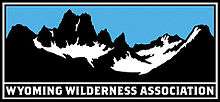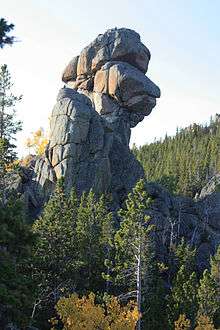Wyoming Wilderness Association

The Wyoming Wilderness Association is an American non-governmental, not-for-profit working to protect Wyoming's wild public lands through wilderness designations. WWA was founded in 1979 by a group of wilderness advocates and outdoors people who envisioned the first Wyoming Wilderness Act. In 1984, the passage of the Wyoming Wilderness Act brought to all Americans the permanent protection of an additional 1.1 million acres of ecologically diverse, wild country in Wyoming. WWA was instrumental in passing the act by educating and train activists on a grassroots level. In 2003, WWA was reborn with a new opportunity to protect additional wild watersheds, intact ecosystems, old-growth forests, important wildlife habitat, and wildlife migration corridors – wild landscapes that truly deserve lasting protection as wilderness.[1] As of 2012, the organization has over 700 members with offices in Sheridan, Buffalo, Lander, Dubois, and Jackson Wyoming.
Currently, the whole wilderness system in Wyoming is roughly three million acres. Five million acres of spectacular wild land still remain unprotected and vulnerable to development.[2] Not one acre of new wilderness has been protected in Wyoming since 1984!
On February 10, 2012, The Wyoming Wilderness Association celebrated its 10th anniversary advocating for more wilderness in Wyoming.[3]
Campaigns
Although the Wyoming Wilderness Association is involved in campaigns to designate new wilderness in Wyoming, not all public lands in Wyoming are undeveloped and have wilderness potential. From agency recommendations and citizens' proposals, WWA has prioritized the "gem" roadless areas that are left over after large-scale industrial development from oil gas and mineral extraction. These campaigns below represent the current efforts and direction of the organization.
Rock Creek recommended wilderness
The Rock Creek recommended wilderness area was recommended for wilderness in the 2005 Bighorn National Forest Management Plan. WWA has garnered over 500 business and 1400 individual letters of support in favor of Rock Creek as congressionally designated wilderness.[4]

Shoshone National Forest
Currently the Shoshone National Forest (SNF) is revising its management plan, which will determine the management direction of the forest for the next 10–20 years. The SNF is home to prized wildlife habitat and vast tracts of roadless land in the Greater Yellowstone Ecosystem. Although 34 roadless areas have been inventoried by the forest service, very few have been recommended for wilderness and most are under attack to be released from roadless protection. This forest is surrounded by some of the largest oil and gas fields in Wyoming and pressure is mounting to drill on the forest.[5] Currently, off-road vehicles and all-terrain vehicles are increasing efforts to open roadless areas to road development and motorized trails.[6] WWA is seeking more agency cooperation and consideration of public comment supporting roadless.
Bridger-Teton National Forest
In the past, WWA has been very active in the Bridger-Teton region. Educational efforts culminated in the publication of "Living in Wild Country", which is a user-friendly guide to help people understand the value of Wyoming's extraordinary wild landscapes and what they can do to help keep them wild.[7] Efforts are ramping up to educate the public on a massive fuels reduction plan for fire mitigation that would compromise wilderness characteristics in the Palisades Wilderness Study Area.[8]
BLM
Wyoming is home to over 18 million acres of Bureau of Land Management (BLM) lands which consist of some of the best wildlife habitat, hunting and fishing; however not one acre of BLM land has been designated as wilderness. After large-scale fossil fuel extraction across the state, only a small fraction of roadless land and Wilderness Study Areas remains undeveloped and even these areas are under the threat.[9] WWA is currently involved in Resource Management Plan (RMP) revisions across Wyoming, which guide the BLM's management policies for the next 15–20 years, and is continually seeking more public comment to the BLM regarding preservation of wilderness resources and advocacy for more recommended wilderness areas. WWA has also created an on-line guide to help the public better understand the RMP process and how citizens can advocate for protection of more BLM lands in Wyoming.[10]
References
- ↑ Gable. "BLM considers 'wild lands' in Wyoming". Red Lodge Clearing House. Retrieved 4/12/2012. Check date values in:
|access-date=(help) - ↑ Wilderness in Wyoming. "Living & Playing in Wyoming's Wild Country - A Primer on Appreciating and Protecting the Wild Country of Wyoming". Retrieved 12 April 2012.
- ↑ http://www.wildwyo.org
- ↑ "WWA Rock Creek". Retrieved 2012-03-27.
- ↑ WyoFile http://wyofile.com/2012/02/shoshone-drilling-project-wins-blm-approval/. Retrieved 2012-03-21. Missing or empty
|title=(help) - ↑ Billings Gazette http://billingsgazette.com/news/state-and-regional/wyoming/backcountry-horsemen-at-odds-with-orv-use-in-shoshone-national/article_c6e13d1d-597d-5b4e-bd11-14bb0f7d2467.html. Retrieved 2012-03-21. Missing or empty
|title=(help) - ↑ "Living And Playing in Wild Country Interactive Guide". Retrieved 2012-03-27.
- ↑ "WWA BT". Retrieved 2012-03-27.
- ↑ WyoFile http://wyofile.com/2011/06/wild-lands-bullet-dodged-oil-still-spills-in-wyoming/. Missing or empty
|title=(help) - ↑ "WWA BLM". Retrieved 2012-03-27.